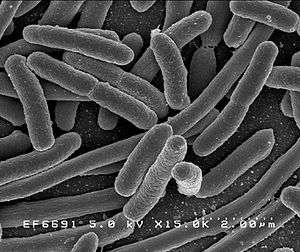Gracilicutes
| Gracilicutes | |
|---|---|
 | |
| Escherichia coli cells magnified 25,000 times | |
| Scientific classification | |
| Domain: | Bacteria |
| (unranked): | Gracilicutes Gibbons and Murray 1978[1] |
| Kingdoms/Phyla | |
Gracilicutes (Latin: gracilis, slender, and cutis, skin, referring to the cell wall) is a controversial taxon in bacterial taxonomy.
Traditionally gram staining results were most commonly used as a classification tool, consequently until the advent of molecular phylogeny, the Kingdom Monera (as the domains Bacteria and Archaea were known then) was divided into four phyla,[2][3]
- Gracilicutes (gram-negative, it is split in many groups, but some authors stil use it in a narrower sense)
- Firmacutes [sic] (gram-positive, subsequently corrected to Firmicutes,[4] today it includes the Mollicutes but excludes the Actinobacteria)
- Mollicutes (gram variable, posteriorly renamed as Tenericutes, e.g. Mycoplasma)
- Mendosicutes (uneven gram stain, "methanogenic bacteria" now known as methanogens and classed as Archaea)
This classification system was abandoned in favour of the three-domain system based on molecular phylogeny started by C. Woese.[5][6]
This taxon was revived in 2006 by Cavalier-Smith as an infrakindgom containing the phyla Spirochaetae, Sphingobacteria, Planctobacteria, and Proteobacteria.[7] However, this taxon is not generally accepted and the three-domain system is followed.[8]
It is a gram-negative clade that branched off from other bacteria just before the evolutionary loss of the outer membrane or capsule, and just after the evolution of flagella.[7]
Relationships
The following graph shows Cavalier-Smith's version of the tree of life, indicating the status of Gracilicutes.[9]
|
Legend: |
References
- ↑ Gibbons, N. E. & Murray, R. G. E. 1978. Proposals concerning the higher taxa of bacteria. Int J Syst Bacteriol 28:1–6, (PDF)
- ↑ Gibbons, N.E. & Murray, R.G.E. (1978). Proposals concerning the higher taxa of bacteria. International Journal of Systematic Bacteriology, 28, 1-6, .
- ↑ Krieg, N.R. & Holt, J.C. (eds., 1984). Bergey’s Manual of Systematic Bacteriology, 1st ed., vol. 1, Williams and Wilkins, Baltimore, .
- ↑ Murray, R.G.E. (1984). The higher taxa, or, a place for everything...?. In: N.R. Krieg & J.G. Holt (ed.) Bergey's Manual of Systematic Bacteriology, vol. 1, The Williams & Wilkins Co., Baltimore, p. 31-34
- ↑ Woese, C. R. (1987). "Bacterial evolution". Microbiological reviews. 51 (2): 221–271. PMC 373105
 . PMID 2439888.
. PMID 2439888. - ↑ Don J. Brenner, Noel R. Krieg, James T. Staley (July 26, 2005) [1984(Williams & Wilkins)]. George M. Garrity, ed. Introductory Essays. Bergey's Manual of Systematic Bacteriology. 2A (2nd ed.). New York: Springer. p. 304. ISBN 978-0-387-24143-2. British Library no. GBA561951.
- 1 2 Cavalier-Smith T (2006). "Rooting the tree of life by transition analyses". Biol. Direct. 1: 19. doi:10.1186/1745-6150-1-19. PMC 1586193
 . PMID 16834776.
. PMID 16834776. - ↑ Krieg, N.R.; Ludwig, W.; Whitman, W.B.; Hedlund, B.P.; Paster, B.J.; Staley, J.T.; Ward, N.; Brown, D.; Parte, A. (November 24, 2010) [1984(Williams & Wilkins)]. George M. Garrity, ed. The Bacteroidetes, Spirochaetes, Tenericutes (Mollicutes), Acidobacteria, Fibrobacteres, Fusobacteria, Dictyoglomi, Gemmatimonadetes, Lentisphaerae, Verrucomicrobia, Chlamydiae, and Planctomycetes. Bergey's Manual of Systematic Bacteriology. 4 (2nd ed.). New York: Springer. p. 908. ISBN 978-0-387-95042-6. British Library no. GBA561951.
- ↑ Cavalier-Smith T (2006). "Cell evolution and Earth history: stasis and revolution" (PDF). Philos Trans R Soc Lond B Biol Sci. 361 (1470): 969–1006. doi:10.1098/rstb.2006.1842. PMC 1578732
 . PMID 16754610.
. PMID 16754610.